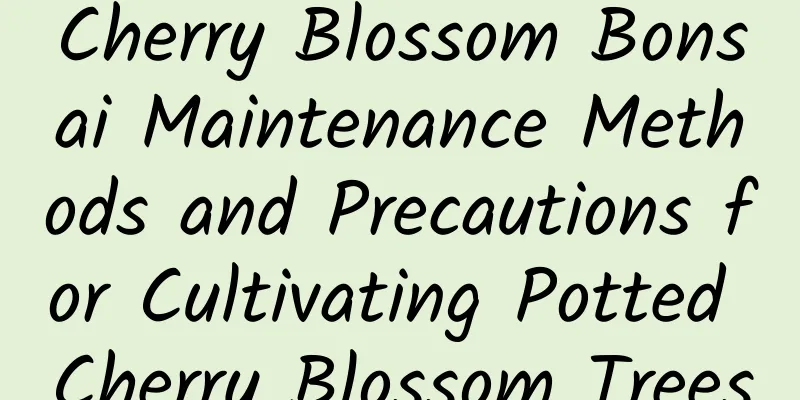Geranium cultivation methods and precautions

Soil selectionThe soil for geraniums can be a mixture of 4 parts humus, 3 parts garden soil (or peat soil), 2 parts river sand (or perlite), and 1 part organic fertilizer. It can also be prepared by mixing fine sand, humus, perlite and organic fertilizer. Geraniums require loose and breathable soil. They can be repotted or the soil can be loosened in time every autumn. Fertilization methodDuring the growth period of geranium, liquid fertilizer should be applied once every 10 to 15 days, and in the peak seasons of spring and autumn, liquid fertilizer should be applied once every 7 to 10 days. Nitrogen fertilizer should be used mainly before budding, and phosphorus and potassium fertilizers should be used mainly after budding, with a concentration of 0.1% to 0.2%. If you keep it indoors in winter, the temperature will be high and it will basically not stop growing, so you can apply appropriate fertilizer. In summer, when the temperature is high, the plants are in a semi-dormant state and fertilization should be stopped. It is best to fertilize in the evening and water the next morning. Watering methodGeraniums should be watered appropriately, preferring dryness to wetness. During the peak growing season in spring and autumn, there should be sufficient water to keep the potting soil moist, but not waterlogged. On cloudy or rainy days, generally do not water or apply fertilizer. Allow the plants to receive appropriate amounts of rainwater, but avoid excessive watering. Otherwise it is easy to cause root rot. In winter, you can try to water the plants according to the indoor temperature to prevent the water temperature from being too low, which will cause the stems and leaves of the plants to turn yellow. (For detailed watering tips, see How to Water Geraniums ) Temperature requirementsGeranium likes warmth, avoids high temperatures and is afraid of cold. The suitable growth temperature for geranium is 15-25℃. The indoor temperature should be maintained at 10℃ in winter. It is easily affected by cold damage below 3℃, but some varieties can withstand temperatures as low as 0℃. In summer, when the temperature exceeds 35℃, it enters a semi-dormant state. Try to keep ventilation and avoid a stuffy environment that is not conducive to dormancy. Lighting requirementsGeraniums are not afraid of strong light, but need shade at noon in summer. Geraniums grow healthily in the sun, with dark green leaves, short internodes and beautiful plant shape. When raising it at home, it should be placed in a place with direct sunlight in autumn, winter and spring. When it blooms, it can be moved indoors for appreciation and maintenance, and receive appropriate light, but avoid direct strong light to prevent the petals from burning. PrecautionsThere are different varieties of geraniums with different plant shapes and heights. Small plants should be chosen for home cultivation. In addition, growth agents are required for regulation. When the plant grows to 12 cm or 15 cm, spray it with chlormequat once a week for 2 consecutive times. Ensure 14 to 18 hours of light per day, which can effectively control the height of geraniums and provide high-quality potted flowers. Be extra careful when watering geraniums. Overwatering can cause the plant to die, while high temperatures and high humidity can cause the roots to rot. Of course, the flowering time can also be controlled. The peak flowering period is generally from April to June, but if the temperature is appropriately increased in winter, it can bloom from September in autumn to June of the following year. |
<<: Cactus cultivation precautions
>>: What are the varieties of geranium?
Recommend
Green radish and camellia...Wrap it in a towel, and it will sprout roots even in the winter, and fill the pot in 20 days!
Wrap the branches of green radish with a towel, a...
When to plant radishes?
Radish is a vegetable with high nutritional value...
Four Seasons Maintenance Tips for Red Flower Jade
Spring and Autumn Maintenance The red flower jade...
What are the cultivation methods and precautions of money leaf
How to grow money leaf soil Money leaf has a cert...
How to grow Monstera in winter, what are the precautions
1. Keep warm Monstera is a plant with poor cold r...
How to prune the umbrella tree
Pruning method Pruning: The umbrella plant can gr...
What to do if Monstera grows crooked
1. Causes Many people like to grow Monstera in th...
How often can rosemary be harvested?
Rosemary is an evergreen shrub native to the Medi...
How often should I water the iron begonia?
How often should I water the iron begonia? Spring...
What to do if the pine red plum blossoms are scattered
The reason why the flowering of Prunus mume is sc...
The cultivation methods and precautions of the succulent plant Qiluo
The Qi Luo succulent itself is a very easy-to-gro...
Do rubber trees like the sun?
Rubber tree likes sunshine Rubber trees love sunl...
Does Jasper Flower prefer shade or sun?
Does Jasper Flower prefer shade or sun? Jade flow...
What are the cultivation methods and precautions of Hosta
How to grow Hosta Hosta is a perennial plant of t...
Anti-aging, lowering blood pressure, and serving as flower fertilizer... the peel of this fruit has so many benefits!
Anti-oxidation and anti-aging, making you 20 year...









